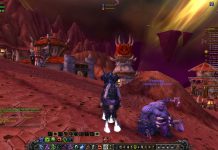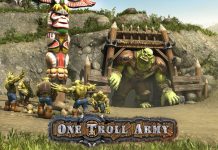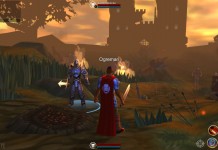Vindictus is a free-to-play MMORPG published by Nexon featuring a stunningly gorgeous graphics engine, an instance system, and a narrative that mixes European culture and mythology with a new bent. New players will be blown away by the extremely careful design to the rendering (if their computers can handle it) good storytelling, huge community, well-developed UI, and thoroughly thought out gameplay elements. As very much a themepark game, Vindictus does a good job of giving players an idea of where to go and what to do and does so without too much intrusion into the game’s immersion.
Expect bias. When I first heard of Vindictus, I avoided it like typhoid. Why? Because I’m American Irish, from an Irish community, and I identify fondly with my ethnicity: I have read a lot of our cultural mythology, I speak the language, and I even used to teach Celtoi studies as an expert. So, the presence of obvious elements of Celtic mythology in the game at first gave me pause. People often use a mishmash of nonsense taken from European cultures in games and do them little justice. As a result, if I hear Irish names, see Irish monsters, and boats covered with Celtic knotwork, I fume slowly as I walk away.
Actually, Vindictus captured my heart when they accurately pronounced Aodhan with proper Irish. Even if they do have gnolls and mention the Fomori in a strange way, I’m fine with that, this is a video game after all and they get a lot of poetic license. The mixture of Irish and English names really amuses me, also there’s a powerful European mixture of culture and affect that rather pulled me in initially. You’ll probably enjoy it as well, the writers and art directors really knew where they were going and drew a very extensive map of how they intended to get there.
Be warned: Vindictus runs AhnLab Hackshield. Unlike many other variants, however, it’s much less intrusive than many rivals. If you don’t like programs that use root access to monitor system-level activity, then be prepared for its presence. The rest of you, however, will probably be calmed in knowing that this game will be difficult for cheaters to prosper in.
Graphics and Sound: Like a good movie, this game has excellent polish
This game has high quality and production value written all over it. From the moment that I finished installing and logged in, I was greeted by a beautiful rendering of a Celtic dragon-boat sailing through a river with a sun glowing in the sky. It’s nothing short of beautiful and pushes my computer’s video card resources to their limit.
Walking around town tells this tale better than anywhere else. The first thing I meet the moment I come into town? Tiny little Shinu-iba puppies (okay, so they’re supposed to be some sort of Husky puppy I think) that totter around, yip quietly, turn their heads. The game even has very realistic horses stabled at a building nearby, and pigs oinking, and chickens running about. You can get very close to the textures and models of the buildings and it’s obvious they’re extremely detailed and carefully rendered.
This doesn’t stop after the quest-hub of the town and also extends to the details put on the enemies who are fearsome monstrosities wearing armor and silver-spiked helmets.
The game handles its alcohol well also—by this I mean when you have a large group of people and the renderer isn’t done downloading all their clothing and bling. Instead of a blank faced character, you see a person wearing a drab, brown cowled robe. After a few moments the game catches up and they get their equipment instead. This did a good job of not breaking immersion for me even though it felt strange; at least it wasn’t a weird featureless model or a regular citizen.
When I entered buildings, I discovered the next element of Vindictus’s art direction: cartoonish character portraits and dialogue. The insides of buildings are not rendered so much as carefully designed panormas that pans in the screen while I’m doing my business. The detail is huge and the atmosphere is good. Characters in the building appear as portraits who chat in text and deliver messages. The art for their portraits uses clean lines and does a good job of looking like individuals of European descent.
Player characters, however, are a little bit odd. When it comes down to it, the avatars that we get to play in game look like they’re ethnically Korean and just wearing European armor and costumes. This is especially apparent on the mage character (the one I played primarily) and it created a rather funny effect for a game that felt like it’s been set so solidly in the British/Irish countryside. I guess this is a consession we have to make for a publisher like Nexon who are based out of Korea and their primary audience therefore would prefer East Asian faces.
As for sound, it’s superb. The game may not voice as many characters as I’d prefer, but in the end it doesn’t matter—the game still pulled me in and kept me there with the way that things interact, the sights and sounds in culmination, and I learned to recognize the telltale snarling of the gnolls as I advanced around the corner. When Karok hits something, there’s a suitably visceral crunch and when my mage throws her firepalls there’s screaming and fire. Normally, that’s all I’d need but the game does an excellent job of adding the extra dimension of excellent-quality sound.
Gameplay: Themepark MMO to its core with brilliant storytelling
Character customization is minimal and there are only four classes to choose from: sword-and-board warrior, two-blades warrior, mage, and giant—there’s a hint as to a forth hidden in shadow who looks like an archer with a Green Man mask, but he’s not enabled yet.
The sword-and-sheild warrior is named Fiona (female only) and fights like your standard warrior, slashes with her sword and protects with her shield. The dual-wielding warrior is named Lann (male only) and fights with two swords, he does a lot of damage close up and dodges nimbly when he needs to. The mage is named Evie (female only) and while she has virtually no defense, she weilds devastating magic that destroys at a distance. The last, Karok (male only) is a giant man who carries what basically amounts to a war-log into combat; he can even pick up smaller enemies and pummel foes with them (or just suplex them against the ground.)
Unfortunately for Vindictus it runs headlong into one of my bête noir: gender locked character classes. Not only does the game have a limited few classes to choose from, I can’t even choose my gender. Sure, this means that they’d have to think about outfits for twice as many models than they originally have; but gender is tightly tied to identity for humans. Plus, I’d really love to see Karoka the Pillar of Strength as giant hulking women as well; or flamboyant, svelte boys wearing high school uniforms throwing force missiles and fireballs.
All battles are fought in instances and they’re available through the main quest hub (in the beginning this is the village) via boats. Leaving the village leads to a huge, bucolic expanse of meadow and fields—with sheep!—and a castle in the distance. I haven’t explored fully to see where it goes, but there’s no combat enabled there. All the missions from level 1 to 10 seem to engage a narrative about the story presented during the tutorial, which did an excellent job of teaching me how to use my character.
For movement and attack, there’s a little bit of a learning curve. It follows the standard WASD key set and attacks are tied to mouse buttons—with a secondary attack on F—the combat is a little bit less fluid than it should be for a game that focuses so heavily on the mouse. With Evie, for example, throwing a spell causes her to lock up for the animation and she can throw spells really fast. This tends to break the frenetic pace of combat a bit and means that the player will have to rely on lining up shots and not throwing their all into an attack (lest their opponent flank them while they’re still throwing an attack.)
Beginning enemies are gnolls—former agents of the Fomori—they appear as gristly, humanoid hyena creatures wearing armor and swinging spiked clubs.
The major flaw here is that combat really does get repetitive. To mix this up a little, some zones have traps that must be avoided, like steam-powered spike rollers, or falling bits of masonry, but these don’t really do that much more than damage everyone in the party. In fact, I found myself revisiting the same instance three or four times to finish up one mission (due to drops.)
What made it more interesting was the fact that the game allows you to set “oaths” (in true Irish fashion) that are basically limitations for completing an instance that produce extra rewards when succeeded.
Conclusion: Come for the superb graphics, stay for the people
It’s possible to go even higher with Vindictus’s rendering engine than I run it (and it taxes my machine at Normal) but it’s also possible to pull it way down. I’m not sure if it’s still beautiful at lower rendering settings, but people have discussed reducing it in order to reduce lag and enhance the experience.
All that said, I never wanted for a group to head out into instances with. The game even has in-game VOIP enabled so you can use your own voice to speak with other people, should you choose to. In fact, more than once other people spoke to me to ask questions while instancing. For even a short week of gaming, I have six friends in game that I see time to time and ask to come with me to fight gnolls and the Fomori threat.
For someone who is deeply into story and loves reading narrative, Vindictus has really delivered. It’s engaging, interesting, and provides a great deal of compelling story—not to mention cute NPCs with their own trials and problems that I found myself sucked into.
In conclusion: Vindictus makes the grade as a game borrowing from Irish mythology.




















Vindictus may be the most under-rated and under appreciated MMO game. It is certainly the best free to play mmo available. It is like you said, production value. How is it that everyone isn’t talking about this game!
I’m singularly impressed by the production value of this game myself. It’s enjoyable, beautiful, and interesting.